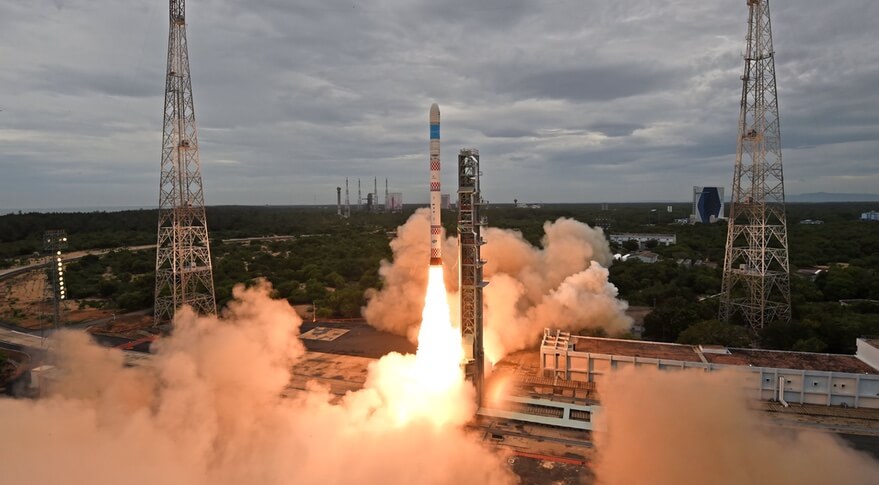
India’s Small Satellite Launch Vehicle (SSLV) lifted off from Satish Dhawan Space Centre Aug. 6 on its inuagural flight, but failed to place its payload of two smallsats into the proper orbit. Credit: ISRO
India’s Small Satellite Launch Vehicle (SSLV) lifted off from Satish Dhawan Space Centre Aug. 6 on its inuagural flight, but failed to place its payload of two smallsats into the proper orbit. Credit: ISRO
Updated 12:30 p.m. Eastern with confirmation of launch failure.
SEOUL, South Korea — The inaugural launch of India’s Small Satellite Launch Vehicle (SSLV) failed to reach orbit Aug. 6 when the rocket’s kick stage malfunctioned.
The three-stage vehicle, capable of placing up to 500 kilograms of payload to a 500-kilometer low Earth orbit, lifted off at 11:48 p.m. Eastern from Satish Dhawan Space Centre’s launch pad No.1, carrying the 135-kilogram Earth observation satellite EOS-02 built by the Indian space agency ISRO and an eight-kilogram cubesat AzaadiSAT, made by Indian students.
Live footage showed the 34-meter rocket, decorated with India’s national flag, soaring into the air. The rocket’s three lower stages used a solid fuel, hydroxyl-terminated polybutadiene, while its final stage, called the Velocity Trimming Module (VTM), used thrusters powered by hydrazine and mixed oxides of nitrogen for the precise deployment of its payloads.
Flight events seen on the live-streamed screen indicated that the rocket’s flight began smoothly. The first stage was separated about two minutes after liftoff as planned, and the second stage did so 3.5 minutes later. The third stage’s separation took place 10.7 minutes after liftoff. The last available data on the screen was that the injection module’s ignition began 10.8 minutes after liftoff but cut off after just one tenth of a second. At one point, the footage showed the EOS-02 satellite being deployed from the module.

S. Somanath, chairman of ISRO, said in remarks a short time later that the first three stages had performed as expected, but “some data loss” had occurred in the final phase of the flight. He did not disclose additional details about the problem but said more details would be announced later. ISRO then ended the launch webcast.
Several hours later, ISRO announced that the VTM had malfunctioned, deploying the satellites into an elliptical orbit of 76 by 356 kilometers, instead of the intended circular orbit of 356 kilometers. “Satellites are no longer usable,” ISRO stated, and likely reentered over the Pacific Ocean.
ISRO said that “failure of a logic to identify a sensor failure” and take corrective action caused the satellites to be deployed into the wrong orbit. ISRO didn’t state if that was linked to the apparent shutdown of the VTM’s thrusters after a tenth of a second.
“This issue related to the SSLV has been reasonably identified, but we will go deeper into it,” Somanath said in a video posted on ISRO’s website. “The system has a deficiency which we need to look at very carefully.”
He emphasized that the first three stages all worked as expected. “The entire vehicle’s performance was very good in the mission,” he said. Other than the VTM malfunction, “we couldn’t see any other anomaly. Every other new element that has been incorporated into this rocket worked very well.”
He was optimistic that the problem can be corrected quickly. “We hope that, with the small corrections and other re-validation of those corrections through an adequate number of tests, we’ll come back for launch for the next development flight of the SSLV, SSLV-D2, very soon.”
ISRO developed SSLV with the aim of providing cheaper and more flexible access to space, compared to its two operational vehicles, the Polar Satellite Launch Vehicle (PSLV) and the Geosynchronous Satellite Launch Vehicle (GSLV). To that end, SSLV was designed to be configured with a simple modular interface, and the vehicle’s assembly can be done horizontally and vertically.
Development of SSLV started in 2017 with an original goal of a first launch as soon as 2019. Its development was delayed by both technical problems, including the failure of a first-stage motor in a static-fire test in 2021, as well as an overall slowdown in Indian space activities linked to the pandemic.
Senior Staff Writer Jeff Foust contributed to this article from Logan, Utah.








